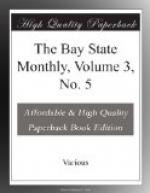But, after all, the route by the Hoosac River had been and continued the main path from Canada to New England for the French and their savage Indian allies. Whether they came down the Hudson to the mouth of the Hoosac at Schaghticoke, or struck that river on the flank at Eagle Bridge, there was a well-beaten trail—the old Mohawk trail—along the north bank of that river all the way from Schaghticoke to what is now North Adams; and, in continuation of that river trail, the “old Indian path” over the Hoosac Mountain, directly over the line of the present Hoosac Tunnel, led down to the upper reaches of the Deerfield river and so down to the Connecticut at old Deerfield. It became, therefore, of great moment to Massachusetts to defend the line of the Deerfield in the French and Indian war of 1744-48. A few private houses were fortified in what is now Bernardston, and two or three more further west in Coleraine, particularly Fort Lucas and Fort Morrison, the owners being assisted by grants of men and supplies from the General Court; and during this war and more especially the next and last French war, the Indians often lurked with hostile intent in the vicinity of these extemporized forts, and not infrequently surprised and killed and scalped men from the little garrisons, and carried women and children into captivity to Canada.
But the first regular fort built to protect the valley of the Deerfield and incidentally also the line of the Connecticut, was placed by Massachusetts in the present town of Heath. It was built wholly at the public expense, and garrisoned by regularly enlisted or impressed soldiers, and named Fort Shirley from the enterprising Governor of the Province. John Stoddard of Northampton was then Colonel of the militia of Hampshire, a designation at that time including all of Massachusetts west of the Connecticut River; he was Shirley’s right-hand man for this end of the Province, and it was under his general direction that Forts Shirley and Pelham and Massachusetts were erected.
The letter is still extant in Stoddard’s own hand, dated July 20, 1744, in which Capt. William Williams is ordered by him “to erect as soon as may be” a block-house sixty feet square “about five miles and a half from Hugh Morrison’s house in Colrain in or near the line run last week under the direction of Col. Timo. Dwight by our order.” In the same letter, Williams is directed to employ soldiers in the construction of the fort, carpenters to be allowed “nine shillings, others six shillings a day old Tenor.” Several other directions are given, and the main outlines of the fort are prescribed; some bills are still extant giving items of money paid out for many different parts of the work; six of the original hewn timbers of the building are in good preservation today in the barn of Orsamus Maxwell in Heath, each stick telling some tale of the original mode of construction; so that, from all these sources of information, a pretty accurate idea of the old fort can be made out to-day, 141 years after it was built.




